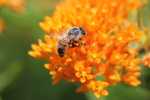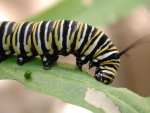Butterfly Milkweed
Asclepias tuberosa or Butterfly Milkweed is a perennial native plant that blooms May through September in zones 4-9. It spends these months attracting and feeding butterflies. Milkweed is a pollinator friendly plant favored by the gorgeous Queen and Monarch butterflies.
Physical Characteristics Of Orange Milkweed
Orange Milkweed is one of 15 milkweed species native to Missouri. It grows 18 to 24 inches tall, with a 24-inch spread. The hairy dark green stems and foliage provide a wonderful contrast to the bright orange heads. The vibrant orange flowers also make it stand out against the fields and open rocky areas that it prefers to grow in.
Other Common Names For Asclepias Tuberosa
- Butterfly Milkweed
- Orange Milkweed
- Pleurisy Root
- Chigger Flower
This small bush-like flower grows a very large taproot. The root makes transplanting this plant very difficult, so it is better to propagate from seed. The root also gives the plant the name Pleurisy Root. Native Americans chewed the tough root to help with a variety of pulmonary ailments or inflammation of the chest and lungs. This was thought to help with things like bronchitis, seasonal allergies, and other respiratory problems.
Help Save the Monarch
By Adding Milkweed
To Your Garden 
Yep, I am sure you have heard somewhere by now about this. The Monarch butterfly species is diminishing and milkweed may be the cure. The National Wildlife Federation has some great information about the topic. Some facts about milkweed and the Monarchs:
- Orange Milkweed is most commonly known for attracting hummingbirds and the diminishing Monarch butterfly.
- It is a plentiful source of nectar for the Monarch. There is a chemical in native milkweed that is thought to be the source of the butterfly’s toxic and bitter-tasting properties.
- Milkweed is also the only plant that Monarchs lay their larvae in.

A study done earlier this year in 2016 has seen a ten-fold drop in the number of Monarch Butterflies over the past decade. At this rate, scientists are estimating a high probability that they could go extinct in the next twenty years. Propagating and promoting the native species of milkweed that attract them and feed their young may very well help bring the Monarch back from their decline for future generations to enjoy. For more information about common plants in the area and pollinators check out the invasive noxious Queen Anne’s Lace or the native Scarlet Catchfly.



